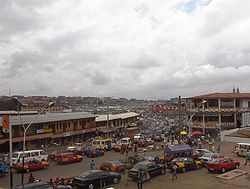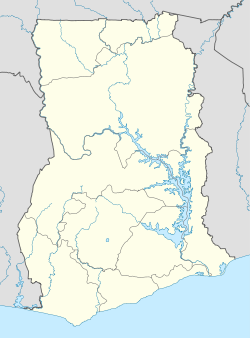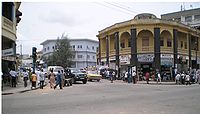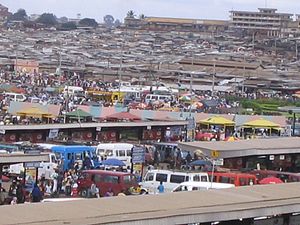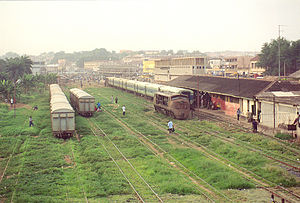
Kumasi
Background Information
This Wikipedia selection is available offline from SOS Children for distribution in the developing world. With SOS Children you can choose to sponsor children in over a hundred countries
| Kumasi | |
|---|---|
|
|
|
| Coordinates: 06°41′N 001°37′W Coordinates: 06°41′N 001°37′W | |
| District of Ghana | Kumasi Metropolitan District |
| Government | |
| • Chief Executive | Samuel Sarpong |
| Area | |
| • Metro | 299 km2 (115 sq mi) |
| Population (2005) | |
| • Urban | 1,517,000 |
| • Metro | 2,500,000 |
| estimated | |
| Time zone | GMT |
| • Summer ( DST) | Not used ( UTC) |
| Website | www.kumasimetro.org |
Kumasi (historically spelled Coomassie ) is a city in southern central Ghana's Ashanti region. It is located near Lake Bosomtwe, in the Rain Forest Region about 250 kilometres (160 mi) (by road) northwest of Accra. Kumasi is approximately 300 miles (480 km) north of the Equator and 100 miles (160 km) north of the Gulf of Guinea. It is popularly known as "The Garden City" or "heart beat" of Ghana because of its many beautiful species of flowers and plants.
Demographics
With a population of 1,517,000, Kumasi is the second-largest city in the country. The largest ethnic group is the Ashanti, but other ethnic groups are growing in size. Approximately 80% of the population is Christian and 5% Muslim, with a smaller number of adherents to traditional beliefs. It is an Anglican diocesan, Roman Catholic archdiocesan see, and a Methodist episcopal area.
History
There is evidence that the area around Kumasi has been kept cleared since the Neolithic age.
The city rose to prominence in 1695 when it became capital of the Ashanti Confederacy due to the activities of its ruler Osei Tutu. The ruler of Kumasi, known as the Asantehene, also served as ruler of the Confederacy. With their 1701 victory over Denkyira the Asante confederacy became the primary state among the Twi speaking Akan peoples.
Parts of the city, including the Royal Palace, were destroyed by British troops in the Third Anglo-Ashanti War of 1874. It remains a royal city, although since all of Ghana was declared independent in 1957, the role of king has been mainly symbolic. The city holds an important place in the history of the Ashanti people, as legend claims that it was here Okomfo Anokye received the Golden stool, an embodiment of the soul of the Asanti nation.
Economy
Due to large gold deposits that have been mined in the area, Kumasi has been among the wealthier cities in Ghana. The city's major exports are hardwood and cocoa. Kumasi has 50% of the timber industry in Ghana, with more than 4,000 employed in the business. The Kaasai Industrial Area plays an important role in industry in the area. The Guinness Ghana Breweries is based there and is listed on the Ghana Stock Exchange.
Climate
Kumasi features a tropical wet and dry climate, with relatively constant temperatures throughout the course of the year. Kumasi is noticeably wetter than nearby Accra, averaging around 1400 mm of rain per year. The city almost features two different rainy seasons, a longer rainy season from March through July and a shorter rainy season from September to November. In actuality, the months of February through November is one long wet season, with a relative lull in precipitation in August. Similar to the rest of West Africa, Kumasi experiences the harmattan during the “low sun” months. Lasting from December to February, the harmattan is the primary source of the city’s dry season.
| Kumasi | ||||||||||||||||||||||||||||||||||||||||||||||||||||||||||||
|---|---|---|---|---|---|---|---|---|---|---|---|---|---|---|---|---|---|---|---|---|---|---|---|---|---|---|---|---|---|---|---|---|---|---|---|---|---|---|---|---|---|---|---|---|---|---|---|---|---|---|---|---|---|---|---|---|---|---|---|---|
| Climate chart ( explanation) | ||||||||||||||||||||||||||||||||||||||||||||||||||||||||||||
|
||||||||||||||||||||||||||||||||||||||||||||||||||||||||||||
|
||||||||||||||||||||||||||||||||||||||||||||||||||||||||||||
Attractions
Features of the city include the large Kumasi Central Market, Tafo kumasi, Fort Kumasi (built by the British in 1896 to replace an Asante fort and now a museum) and the Kumasi Hat Museum. Royal Asante attractions include the Kumasi National Cultural Centre (including the Prempeh II Jubilee Museum with various Asante regalia including a reproduction of the golden stool), the Okomfo Anokye Sword, the Asantehene's Palace (built in 1972), and the Manhiya Palace, dating from 1925, now a museum.
Kumasi is also home to a zoo, and to the Kwame Nkrumah University of Science and Technology of Ghana (formerly the Kumasi College of Technology).
St. Peter's Cathedral Basilica is the seat of the Roman Catholic Archdiocese of Kumasi.
The Kumasi area has one public hospital ( Komfo Anokye Teaching Hospital, 736 beds), five public clinics and 57 private clinics (1992 figures).
The city's most famous son is the former Secretary-General of the United Nations, Kofi Annan. Professional wrestler Kofi Kingston was also born in Kumasi. The local football (soccer) team, the Kumasi Asante Kotoko has won several national and continental awards. Their stadium was built in 1959, renovated in 1978, and again in 2007 with a seating capacity of 40,000 .
Festivals and Events
The Adae Kese Festival is a very important, albeit rare, celebration of the Ashanti's. It is held in a large open space in the capital city of Kumasi. The festival is normally well attended and embraced by Ashanti's from all walks of life.
Basically, the Adae Kese celebrations are magnified forms of Sunday Adae festivals, celebrated every six weeks in accordance with the Akan ca lender which is based on a cycle of forty- two days and nine months in a year. Invariably, the last Akwasidae festival is set aside for the celebration of Adae Kese.
Adae Kese is usually held to climax celebrations of specific milestones and achievements of the Asante kingdom. it was first celebrated to mark the attainment of statehood of a newly celebrated people, in the aftermath of the Ashanti war of independence, otherwise known as the ""Battle of Feyiase"", which was fought against the Denkyiras between 1697 and 1699. Adae Kese, like other Akwasidae events, serves as the platform for pledging allegiance to the kingdom and to affirm loyalty to the occupant of the Golden Stool which represents the unity and embodiment of all Ashanti.
The event is marked in two phases. There are solemn private observances which are performed at the King's palace chambers by accredited members of the royal family and other functionaries. It includes rituals, aimed at cleansing the spirit of the incumbent King and the presentation of ceremonial sacrificial meal (Esq.) and drinks to ancestral spirits. Their blessing and protection guide the kingdom to prosperity.
The public celebrations take the form of a colourful durbar of chiefs and queen mothers presided over by the Asantehene. It involves the display of cherished regalia and paraphernalia accompanied by traditional drumming and dancing as well as firing of musketry amidst pomp and pageantry.
The Adae festival is a continuous demonstration of faith in the vision and heritage of the Asante Kingdom, which has existed since the introduction of the Golden Stool in 1700.
The festival is also to commemorate and re-enforce the independence of the Ashanti people and an occasion to re-affirm each state's loyalty to the confederacy instituted in the aftermath of the Ashanti war of independence fought against the Denkyeras between 1697-1699. It provides a platform for the King to meet and share his thoughts with his sub-chiefs and subjects and also reward deserving ones.
Time your visit to coincide with an Akwasidae Festival, (Sunday Adae). You can determine the Akwasidae dates by counting 6 weeks down the calendar from 1 Adae. For example, in 1991 the dates were: January 6, February 17, March 31 May 12, June 23, August 4, September 15, October 27, December 8.
Transportation
Kumasi is served by Kumasi Airport and railway lines to Accra and Takoradi. Because of the barrier mountain range just to the north, the rail system does not yet go further to the north.
Public transit in the city is provided by a mix of privately owned Mini-buses (known as Tro-Tros), taxis and buses. Tro-Tros are usually converted Mini-buses that run a regular, well-known route. Some taxis also run regular routes, which cost more but provide for a more comfortable ride. Recently in 2002, the city introduced metro bus services, which were initially met with scepticism by commuters, but have increased in popularity.
As of 2007, Boankra Inland Port is being built about 25 km away.
